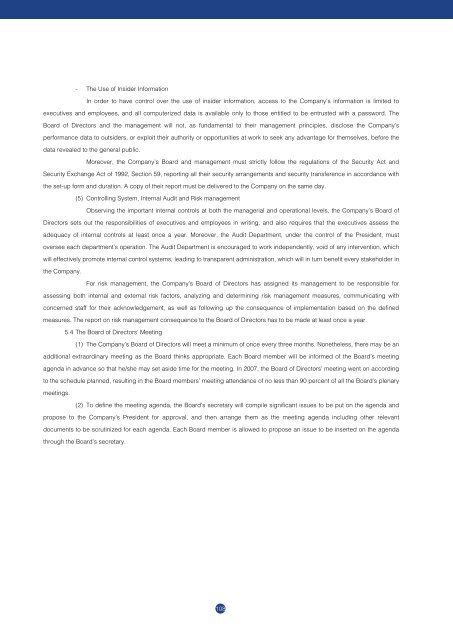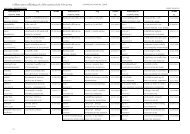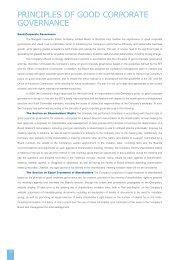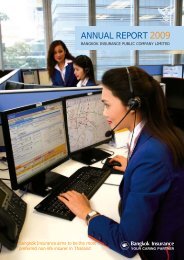Year 2007
Year 2007
Year 2007
Create successful ePaper yourself
Turn your PDF publications into a flip-book with our unique Google optimized e-Paper software.
- The Use of Insider Information<br />
In order to have control over the use of insider information, access to the Company’s information is limited to<br />
executives and employees, and all computerized data is available only to those entitled to be entrusted with a password. The<br />
Board of Directors and the management will not, as fundamental to their management principles, disclose the Company’s<br />
performance data to outsiders, or exploit their authority or opportunities at work to seek any advantage for themselves, before the<br />
data revealed to the general public.<br />
Moreover, the Company’s Board and management must strictly follow the regulations of the Security Act and<br />
Security Exchange Act of 1992, Section 59, reporting all their security arrangements and security transference in accordance with<br />
the set-up form and duration. A copy of their report must be delivered to the Company on the same day.<br />
(5) Controlling System, Internal Audit and Risk management<br />
Observing the important internal controls at both the managerial and operational levels, the Company’s Board of<br />
Directors sets out the responsibilities of executives and employees in writing, and also requires that the executives assess the<br />
adequacy of internal controls at least once a year. Moreover, the Audit Department, under the control of the President, must<br />
oversee each department’s operation. The Audit Department is encouraged to work independently, void of any intervention, which<br />
will effectively promote internal control systems, leading to transparent administration, which will in turn benefit every stakeholder in<br />
the Company.<br />
For risk management, the Company’s Board of Directors has assigned its management to be responsible for<br />
assessing both internal and external risk factors, analyzing and determining risk management measures, communicating with<br />
concerned staff for their acknowledgement, as well as following up the consequence of implementation based on the defined<br />
measures. The report on risk management consequence to the Board of Directors has to be made at least once a year.<br />
5.4 The Board of Directors’ Meeting<br />
(1) The Company’s Board of Directors will meet a minimum of once every three months. Nonetheless, there may be an<br />
additional extraordinary meeting as the Board thinks appropriate. Each Board member will be informed of the Board’s meeting<br />
agenda in advance so that he/she may set aside time for the meeting. In <strong>2007</strong>, the Board of Directors’ meeting went on according<br />
to the schedule planned, resulting in the Board members’ meeting attendance of no less than 90 percent of all the Board’s plenary<br />
meetings.<br />
(2) To define the meeting agenda, the Board’s secretary will compile significant issues to be put on the agenda and<br />
propose to the Company’s President for approval, and then arrange them as the meeting agenda including other relevant<br />
documents to be scrutinized for each agenda. Each Board member is allowed to propose an issue to be inserted on the agenda<br />
through the Board’s secretary.<br />
108







